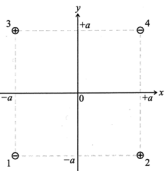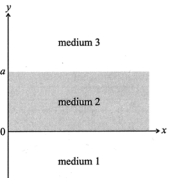Reference no: EM13964613
1. (a) Four point charges are placed at the vertices of a square as shown in the diagram. The charges are of equal magnitude, Q, the sign of each charge is given in this diagram.

(i) What is the value of ∇x E at all spatial points in this con?guration of charges (note that the charges are stationary)? What is the signi?cance of this result?
(ii) What is the electrostatic potential, ∇, at the following points: (0,0), (0, +a), (+a, 0)?
(iii) How much total work must be done to bring a charge of -2Q from spatial in?nity and place it at the origin?
(iv) With this ?fth point charge (i.e., -2Q) at the origin, how much total work must be done to place a sixth charge of +Q at the point (0, +a)?
(b) A dielectric slab (medium 2) is placed in the plane y = 0 and is surrounded by two other media as shown in the adjacent diagram. The relative permittivities are εr1 =2.5 for y<0, εr2 = 2.0 for y<a and εr3 = 1.0 for y>0

None of the media contain any free volume or surface charge. In medium 3 there is a uniform electric ?eld.
E3 = i+3j
(i) State the boundary conditions on D and E at the interface between two materials.
(ii) Find the electric ?eld, E2, the electric displacement, D2 and the polarisation vector, Pg, in medium 2.
(iii) Find the surface density of bound charge on both sides of the boundary between media 1 and 2, and on both sides of the boundary between media 2 and 3.
(iv) Does the magnitude of the electric ?eld vary from one medium to the next? If so, in which medium is the magnitude of the electric ?eld the greatest?
|
What is the final temperature of the mixture
: A liter of gas, initially at a pressure of 500Pa, is compressed from 1.00 L to 0.25 L. During the compression process, heat is dissipated to maintain a constant temperature. What is the final pressure?
|
|
How us and russia answer how to produce their economies
: Compare and contrast how the United States, Russia, and Brazil answer the three basic questions of what to produce, how to produce, and for whom to produce in their economies.
|
|
Find the largest prime factor of a given number
: Write a program to find the largest prime factor of a given number N? example: The prime factors of 13195 are 5, 7, 13 and 29.
|
|
Find shortest paths from src to all vertices
: Bellman-ford Algorithm Given a graph and a source vertex src in graph, find shortest paths from src to all vertices in the given graph. The graph may contain negative weight edges.
|
|
Find the electric ?eld, e2, the electric displacement
: Find the surface density of bound charge on both sides of the boundary between media 1 and 2, and on both sides of the boundary between media 2 and 3.
|
|
What factors are argued to influence marginal revenue
: What factors are argued to influence marginal revenue (MR) for each franchise? Explain the expected relationships between each factor (variable) and the MR.
|
|
Problem regarding the dynamic programming
: Dynamic Programming ( 0-1 Knapsack Problem) Given weights and values of n items, put these items in a knapsack of capacity W to get the maximum total value in the knapsack.
|
|
Design a decision support system
: The owner of a hardware store wants to design a decision support system to predict how many and which type of nails she should sell and what information she needs to do so. The scenario is described below:
|
|
Find out the mass of the air in a room 3.00m by 4.00m
: Find out the mass of the air in a room 3.00m by 4.00m by 5.00m given that the temperature is 200 C at atmospheric pressure (1atm = 101000 Pa)
|